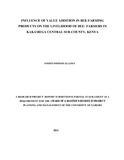| dc.description.abstract | Kakamega central sub-county is endowed ecologically with rainforests such as Malava and Kakamega forests which are well known to attract bees, hence bee keeping is a major practice in the area (IBRA, 2009).Bees are well known for their products that have a lot of economic value, they include honey, beeswax, Propolis and royal jelly (FAO ROME, 2011), the sub-county has the potential to produce 300MTS of honey per year (GOK, 2010).The extent of value addition on hive products and hence its potential benefits has not been established. This study sought to establish whether or not Value addition on hive products would increase income and hence improve the livelihoods of bee farmers, the indicators of which would be the food security status, health/type of houses owned and the education levels in bee farmers’ households. Descriptive research design was employed for this study, the target population under study was 914 bee farmers of which 127 were selected using sampling tables by Krejcie &Morgan (1970).Systematic and stratified random sampling were used to select the respondents from the three strata namely, Municipality, Lurambi and Navakholo. Data was collected by the aid of questionnaires, the validity of the questionnaire was ensured by doing pilot testing, for the reliability, split half reliability was calculated for pilot questionnaires and Spearman’s correlation coefficient computed. Data analysis was done using Statistical Package for Social Science (SPSS), version 16.0.Qualitative data analysis was done by summing up total scores on variables under study, and the final data was analyzed in the form of descriptive statistics (mean, frequencies, percentages and standard deviations) and presented in form of contingency tables. Bee farmers were categorized into three forms of value addition, basic (56.7%), advanced (22.6%) and non-value adders (20.8%). The findings revealed that basic value adders generated Kshs.170 per kilo of honey, advanced, Kshs.211 and non value adders, Kshs.140.Advanced value adders also generated an extra Kshs.150 from sale of royal jelly and Kshs.135 from beeswax. The study established that advanced value adders generated more income hence had better saving culture. Advanced and basic value adders had access to more meals per day and were less likely to suffer from nutritional deficiencies compared to non-value adders. The study concluded that advanced value addition increases income and in return enhances food security, health/housing and education levels of bee farmer families. The study recommended that farmers be trained on the importance of value addition and how to identify hive products and their uses. Financial empowerment of farmers through farmer groups was also recommended as a way of promoting value addition. Finally the study suggested further research to be done on the role played by NGOs that carry out value addition on hive products in the study area in improving farmers’ livelihood | en_US |

